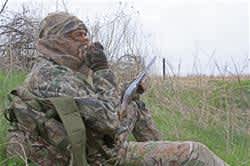Yamaha Outdoors Tip of the Week: Late-season Spring Gobbler Tactics
Yamaha 05.21.13

Yep, spring turkey season is done in some parts of the country. In places like New England and even Nebraska, it runs until the end of May. Maine even ends at noon on June first.
But maybe you’ve hit a wall. You sell those calls like a hot hen, but gobblers aren’t buying. They’d rather run with the red heads. When male turkeys don’t want your sweet hen yelps you need to rethink your hunting tactics. First half, halftime and second half birds can respond differently. You may have to call like a gobbler to pull one into range.
FIRST HALF: Male turkeys might still travel in small gobbler gangs after leaving larger winter flocks. Tracking studies show jakes (juvenile gobblers) often cover the most ground. A dominant longbeard and subordinate male (tom or shortbeard) are common sightings too in transition.
Calling tip: Gobbles draw gobblers. When spring hunting early male groups without hens, locate roosted turkeys by: 1) listening without calling, 2) drawing shock gobbles with an owl, crow or other locator call, or 3) gobbling. Gobble sparingly. Just one well-timed call after fly-down might bring those red heads running. As safety goes, watch for other hunters too.
HALFTIME: Mid-season flocks are pretty much established. A dominant strutter shadows his hens, waiting to breed one. They move from the roost to nearby food sources, where female turkeys later raise broods. Subdominant male birds, toms or jakes, hang close to the boss. Call one away from live hens? Maybe if you act like another interloping gobbler.
Calling tip: Gobble or gobbler yelp to do one of several things: 1) pull in a subdominant gobbler, 2) call in the whole group, as gobbles draw hens too, or 3) fire-up gobblers to fix the flock’s position before your next move. Staking a gobbler decoy at your setup, especially a jake, might seal the deal. Throw in some fighting purrs and gobblers might come running to the fight.
SECOND HALF: Hens disappear and are likely nesting. Days heat up. Gobblers travel together again. Some are still driven to find hens; still others return to male turkey groups, or will soon, and stay this way through summer and autumn. Your waning spring hunt might now do better with some fall turkey calling tactics.
Calling tip: Soft-selling gobbler yelps can interest late-season male spring turkeys just as these calls do in autumn. This call is deeper with a slower cadence—yawp-yawp-yawp—than faster, higher-pitched hen yelps. Make it and keep your eyes and ears open for an approaching red head bobbing through the greened-up woods. I once killed a three-bearded Memorial Day longbeard. You can too if the season is still open where you hunt.

